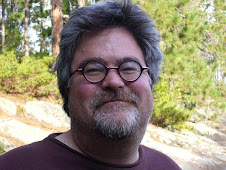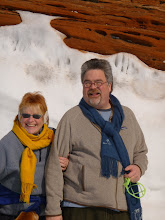Wednesday, October 31, 2007
Yeah , I know, horsepower, noise, toxic fumes, testosterone, and all, but I am a machine guy and..... I love my MINI.
Tuesday, October 30, 2007
Command Central
Follow up on yesterday's steam line "explosion," I saw a new 18 inch diameter expansion joint sitting next to the work site this morning. Since this is one of the most fragile part of a steam distribution system, I expect that the rupture of the existing joint caused the issue yesterday. The new "joint" is a internally pressurized SS bellows unit, usually the district energy folks around here use an externally pressurized unit - I wonder if this is just a temporary unit? The rupture looks like it make have occurred in the expansion joint manhole. The Duluth News Tribune has a photo of the aftermath.

Here is the control center of Building Performance at LHB. Dell notebook computer with Apple sticker and family crest. Sound system for after hour use. Pens, pencils and chopsticks, cups for coffee/tea, calculators (I keep four around) - and lots and lots of paper.
 A few (very few) of the reference books I have around - several by Giovanni on passive building design and climate sensitive design, Kreith ad Kreader's Solar Engineering Textbook (although a newer version than used in my college days), an old NREL solar design guide, Olygay's Design with Climate, the manual for Trace 700, our primary load design and modeling tool.
A few (very few) of the reference books I have around - several by Giovanni on passive building design and climate sensitive design, Kreith ad Kreader's Solar Engineering Textbook (although a newer version than used in my college days), an old NREL solar design guide, Olygay's Design with Climate, the manual for Trace 700, our primary load design and modeling tool.Monday, October 29, 2007
Steam and more Steam
Saturday, October 27, 2007
Out with the Dual Fuel in with the LP heat
 This weekend saw the completion of another personal greenhouse gas reduction project. The removal of our 30 KW dual fuel electric furnace and installation of a 95.6 % efficient LP gas furnace in it's place. The original system was installed perhaps a dozen years ago and used the 1978 vintage LP furnace as the "backup" heat source. Last winter we noticed that the LP unit was leaking combustion products into the supply air and needed to be replaced. Looking at the overall source energy the choice was clear - to convert to LP at the highest efficiency possible.
This weekend saw the completion of another personal greenhouse gas reduction project. The removal of our 30 KW dual fuel electric furnace and installation of a 95.6 % efficient LP gas furnace in it's place. The original system was installed perhaps a dozen years ago and used the 1978 vintage LP furnace as the "backup" heat source. Last winter we noticed that the LP unit was leaking combustion products into the supply air and needed to be replaced. Looking at the overall source energy the choice was clear - to convert to LP at the highest efficiency possible.  The MINI was filled with new ductwork to transition to the new furnace and bypass the old electric unit. The worst of this project was the 2-1/2 inch PVC venting required. This is not a common item and I had some issues getting the parts I needed.
The MINI was filled with new ductwork to transition to the new furnace and bypass the old electric unit. The worst of this project was the 2-1/2 inch PVC venting required. This is not a common item and I had some issues getting the parts I needed.
The duct work fit great and I was able to install the LP conversion kit, adjust the gas pressure at the valve and complete the vent installation. Of course, I started this task at the begining of the month, so it's been a bit of time, but we are just getting to that time of year where the morning temperatures are in the 20's. On Monday, I'll call the LP supplier and get a larger tank installed and a final check of the LP installation - there was a rebate from the LP suppliers, but there was only so much money avalable, so I may have missed it.
Bottom line is that we will most likely pay a bit more for the heat, but the environment will be better for it. I'm hoping two stage gas valve and variable speed the ECM motor will compensate a bit for the higher site energy cost since the original unit was quite a bit more ristricted and had a 2 hp constant speed fan motor.
Friday, October 26, 2007
Boilers and Pig Washers
 Adam and I did a tour of boiler rooms today as part of our field investigation phase of two boiler replacement projects. One project will be pretty straight forward, replacement of two Kewannee firebox hot water heating boilers in an elderly housing complex, 1978 vintage. The boilers are at best operating at 70% annual efficiency and we plan to replace them with high turndown condensing boiler units. The boilers will take up less space save operating costs. While we are there we will look at controlling the exhaust air system, replace some existing electric lighting, and revise the hot water circulating pump piping (which looks like it was installed incorrectly day one). We will use the building Makeup Air Unit and it's glycol loop to subcool the return water and maximize efficiency gains. The other job as programmed is a simple task, replace a oversized steam boiler serving a maintenance building with a pair of properly size units to reduce boiler cycling. We all know that conversion to hot water heating could save more operating cost in the end, but the budget doesn't allow conversion of the five air handling unit coils and the return piping that would be required. The project will save significant amounts of energy - it could save more. I guess it's like personal choices we make in terms of energy, you do the best you can within the parameters in which you live.
Adam and I did a tour of boiler rooms today as part of our field investigation phase of two boiler replacement projects. One project will be pretty straight forward, replacement of two Kewannee firebox hot water heating boilers in an elderly housing complex, 1978 vintage. The boilers are at best operating at 70% annual efficiency and we plan to replace them with high turndown condensing boiler units. The boilers will take up less space save operating costs. While we are there we will look at controlling the exhaust air system, replace some existing electric lighting, and revise the hot water circulating pump piping (which looks like it was installed incorrectly day one). We will use the building Makeup Air Unit and it's glycol loop to subcool the return water and maximize efficiency gains. The other job as programmed is a simple task, replace a oversized steam boiler serving a maintenance building with a pair of properly size units to reduce boiler cycling. We all know that conversion to hot water heating could save more operating cost in the end, but the budget doesn't allow conversion of the five air handling unit coils and the return piping that would be required. The project will save significant amounts of energy - it could save more. I guess it's like personal choices we make in terms of energy, you do the best you can within the parameters in which you live.
Oh yes, the pig washer - we went to look at a machine that is use to wash petroleum pipeline "pigs" to understand how it is connected to water lines and drains. To us it was an 8 foot by 8 foot X on a plan. When we got to the warehouse it was an 8 foot by 8 foot by 16 foot tall wooden crate - we didn't open it up, we didn't see it, we still don't know how to connect it up.
Thursday, October 25, 2007
Ridgewater College, Willmar Tech. Inst.Addition& Ren. Designer Selection
The interview itself occurs in St. Paul with the Board plus representatives of the facility that the project will benefit. The room is small and we have 15 minutes to tell our story and why we will provide the best project outcome and value to the State and the specific project. In our last effort we had a team of 5, Bruce, Sara, Jill Steve, and myself - so we had about 3 minutes each to communicate our message. Usually the MEP person goes last as so is a bit rushed, but this time I had the middle position. As usual, my body reacted a bit to the public speaking by causing me to really heat up as I start talking about the issues, for this project the indoor environment conditions were a key component, so I find myself uncomfortably warm, sort of an ironic thing when you are talking about HVAC. Additional issues include setting energy utilization intensity goals, daylighting in pursuit of those goals, and making sure our MEP designs are flexible enough to accommodate future changes in the central energy plant.
There is a Q and A session at the end of our presentation with questions coming from the board and project users. Throughout the whole process our team, normally physically located in two offices, interacted like the integrated and collaborative team that we say we are. It was really
fun to watch as we supported each other though the presentation and Q and A portion of the interview process.
The SDSB selects two teams to be forwarded to the project facility managers for their final selection. We heard the results about 27 hours after we completed the interview process.
Here's what I e-mailed to the entire firm about my feelings when we found out about getting this project: "I just wanted to add my personal note that the interview team and process was one of the most enjoyable Designer Section Board efforts I have been a part of over the last couple of decades. The real strength of LHB as a collaborative team that enjoys working together to produce buildings that work for our clients was evident in everything we communicated to the DSB and the campus. Our growth into one professional practice focused on sustainability in a regional marketplace also was more evident than before.
Cograts to Bruce and Sara for leading this effort."
Toshio
Technology is my friend!
drives me. That being said, I don't want to program computers or even
design tech objects. I do want to apply scientific and engineering
principles in my work and play, but in an artistic way. More on this
later, this is mainly a test of e-mailing a blog post while walking
from my parking ramp to my office.
Wednesday, October 24, 2007
Greenhouse reduction project FIT/MCS
We reduced our car impact in the following ways - our Toyota T100 which was used as a daily runner at 18 MPG was relegated to country living hauling and snow plowing duty only. It was replaced with a Honda FIT at 36 MPG. This little car is great - hauls a lot of stuff and is great for hauling dogs.
The baby BMW (325xi) at 24 MPG was replaced with a MINI Cooper at 36 MPG.

Yep, we could have purchased higher MPG cars, but this was still a significant reduction is fuel consummed by our family at a cost we could afford - an important measure of sustainability.
First Post
I've been a Google fan for a long long time and like what I see here also. I think my current favorite Google apps are gmail and the iGoogle home page.
Every once in awhile I'll add some food photos and project info for fun too.

